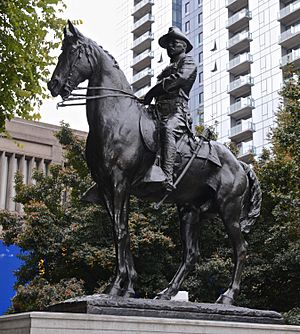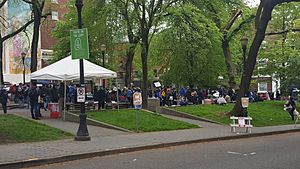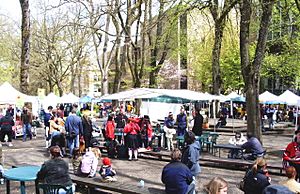South Park Blocks facts for kids
Quick facts for kids South Park Blocks |
|
|---|---|

Part of the South Park Blocks in 2009
|
|
| Type | Urban park |
| Location | Portland, Oregon |
| Area | 8.76 acres (3.55 ha) |
| Operated by | Portland Parks & Recreation |
| Status | Open 5 am to 9 pm daily |
The South Park Blocks are a long, green city park located in downtown Portland, Oregon. People often call it Portland's "extended family room" because it's a welcoming place for everyone, much like Pioneer Courthouse Square is known as the city's "living room."
This park stretches for twelve city blocks. The Portland Streetcar runs through it, and it's a central green space for Portland State University. Many important cultural spots are found here, making it a key part of the city's cultural life. You can find public artworks like Shemanski Fountain (1926), In the Shadow of the Elm, and Peace Chant (1984). There are also statues of famous figures like Theodore Roosevelt and Abraham Lincoln. The park is home to about 337 elm, oak, and maple trees, plus beautiful roses. A special plaque from 1991 remembers the historic Great Plank Road.
Contents
History: How the Park Began
Early Days and Land Ownership
Portland was first mapped out in 1845. A man named Daniel H. Lownsdale bought land south and west of the original city map. In 1848, he created a new map that included 11 narrow blocks, which were smaller than typical city blocks. He then partnered with Stephen Coffin and William W. Chapman. In 1852, they officially set aside the South Park Blocks and some midtown park blocks as public green spaces. This made them the very first official parks in Portland!
Even though they were meant for the public, the city didn't actually own them until September 22, 1870. That's when Mayor Bernard Goldsmith and Chapman agreed to sell the South Park Blocks and two other parks (Chapman and Lownsdale Squares) to the city for $6,250. Most of this money was for the other parks, as the South Park Blocks were still on the edge of the developed city.
Challenges and Changes to the Park
Owning these park blocks wasn't always easy. After Lownsdale passed away, his family argued that the central part of the park wasn't truly given to the public because his wife hadn't signed the legal papers. The courts agreed in 1865. Another person, Benjamin Stark, tried to sell two northern park blocks to the city for a lot of money instead of donating them.
However, Captain John H. Couch did give his section, which became the North Park Blocks, to the city in 1865. Over time, six of the South Park Blocks were lost to private owners in the 1870s. City officials didn't want to spend $6,000 per block to buy them back, especially after just buying land for Washington Park. But just a year later, the price went up to $92,000 for those same six blocks!
In 1907, voters rejected a plan to raise $2 million, which might have included money to buy back the lost blocks. The street name even changed from "West Park" to "Southwest 9th." Luckily, two of these missing blocks have been brought back: O'Bryant Square was bought in 1973, and Director Park opened in 2009.
Park Improvements and Growth
By the late 1870s, fancy Italianate mansions stood along the Park Blocks near what is now Portland State University. In the 1920s, taller buildings like the 12-story Stevens Building and the 9-story Woodlark Building were built nearby, along with several hotels.
In 1912, Edward H. Bennett suggested making the Park Blocks continuous as part of his "Greater Portland Plan." Later, in 1972, one central park block became O'Bryant Square. Director Park was created in 2009, inspired by a 1995 idea to turn that block into a parking lot.
In 1933, the area around Skidmore Fountain was not well-kept, and there was talk of moving the fountain to the South Park Blocks, but it never happened. After a Dutch elm disease outbreak in Portland in 1990, including one tree in the South Park Blocks, the elm trees have been protected with special medicine.
Events and Activities in the Park

The South Park Blocks have been the site of many exciting events over the years.
- On May 5, 1918, a parade of cars started from the South Park Blocks to celebrate the opening of the Historic Columbia River Highway.
- The Portland Rose Festival used to be held here, starting in 1936. By the 1950s, it grew too big for the park. Residents even tried to stop the festival from using the parks, but they lost. By 2007, the festival moved to Tom McCall Waterfront Park.
- The very first Earth Day on April 22, 1970, was celebrated with a fair on the blocks.
- In 1975, Portland's first gay pride fair took place here. It moved to Tom McCall Waterfront Park the next year.
- The Seattle to Portland Bicycle Classic (STP) bike ride used to finish in the South Park Blocks from 1979 to 1998.
- After the September 11 attacks, the Park Blocks filled with people for a candlelight vigil and a free concert by the Oregon Symphony.
- In 2011, the Occupy Portland protest group set up camp in the South Park Blocks.
- Tony n' Tina's Wedding, a fun interactive play, used the park as its stage from 1997 to 1999.
- Artquake, a large art festival, attracted thousands of people on Labor Day weekends from 1982 until at least 2003.
- Movies like The Temp (1992) and The Hunted (2003) have filmed scenes in the South Park Blocks.
- In 2003, an event called Rose City Thunder was held here to celebrate Harley-Davidson's 100th anniversary.
- Many other events have taken place, including the Homowo Festival of African Arts, the Portland Poetry Festival, and the Meier & Frank Holiday Parade.
Protests and Rallies
The South Park Blocks, especially near Portland State University, have often been a place for protests and marches.
- On May 1, 2000, a workers' rights protest gathered hundreds of people. Police made arrests and used special rounds to control the crowd. This led to many complaints about police force.
- In 2006, about 1,200 people protested against the war in Iraq.
- Many large anti-war rallies took place between 2001 and 2008, with thousands of people gathering to protest the 2003 invasion of Iraq.
- In May 1970, a big protest against the Vietnam War and the invasion of Cambodia happened here. Students even blocked streets around the university. Police eventually removed protesters, leading to injuries on both sides. Lawsuits from this event led to the Portland Police agreeing not to use force against peaceful protesters in the future.
Park Improvements for People
In 1973, the southern part of the South Park Blocks was closed to cars, making it a pedestrian-only area and a peaceful center for the university. The park blocks were greatly improved in 1987 with new plazas, large flower beds, better lighting, and paved sidewalks. Several apartment buildings were also built nearby, making it a more lively neighborhood.
Cool Places and Art in the Park

Many important buildings are located near the South Park Blocks, including Portland State University buildings like the Peter Stott Center and Branford Price Millar Library. Other notable places include the Oregon Historical Society, Portland Art Museum, and Arlene Schnitzer Concert Hall.
Every block in the park has public art!
- Shemanski Fountain (1926) was designed by Carl L. Linde and has drinking fountains, even special ones for dogs!
- In the Shadow of the Elm by Paul Sutinen is built right into the pavement.
- Peace Chant (1984) is made of three large granite blocks.
- There are two big statues:
* A large bronze statue of Theodore Roosevelt, Rough Rider (1922) on his horse, standing 18 feet tall. * A statue of Abraham Lincoln (1928), looking thoughtful and facing north.
Current Fun in the Park
The South Park Blocks are still a busy place today!
- Portland State University often holds its summer graduation ceremony here, rain or shine.
- PSU also hosts an annual "Party in the Park" when the school year begins.
Portland Farmers Market
The main Portland Farmers Market is held in the South Park Blocks every Saturday from March to December. It attracts up to 14,000 people each weekend who come to buy fresh, local food. The market started in 1992 at a different location but moved to the Park Blocks in 1998. This Saturday market has become very popular and is known for helping Portland become a famous food city. A smaller market is also held at the north end of the blocks on Wednesdays.
Images for kids




